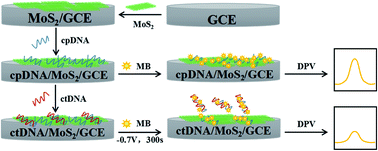An electrochemical biosensor based on few-layer MoS2 nanosheets for highly sensitive detection of tumor marker ctDNA†
Abstract
An electrochemical biosensor based on few-layer molybdenum disulfide (MoS2) nanosheets was fabricated for the highly sensitive detection of tumor marker circulating tumor DNA (ctDNA) in this paper. The MoS2 nanosheets with few layers were prepared by the shear stripping. Compared with the mechanical stripping method and the lithium ion intercalation method, this method is simpler to operate, and the prepared MoS2 nanosheets had good electrochemical activity. The biosensing platform was fabricated based on the discriminative affinity of MoS2 nanosheets towards single-stranded DNA (ssDNA) and double-stranded DNA (dsDNA). Methylene blue (MB) was used as the signal molecule. The results showed that the detection of ctDNA by this sensor showed an excellent linear relationship in the concentration range of 1.0 × 10−7 M to 1.0 × 10−16 M, and the detection limit was 2.5 × 10−18 M. In addition, this sensor exhibited outstanding stability and specificity. This strategy provides an alternative approach for ctDNA detection and an effective sensing strategy for future in vitro cancer diagnosis by label-free detection.

- This article is part of the themed collection: Analytical Methods HOT Articles 2022


 Please wait while we load your content...
Please wait while we load your content...